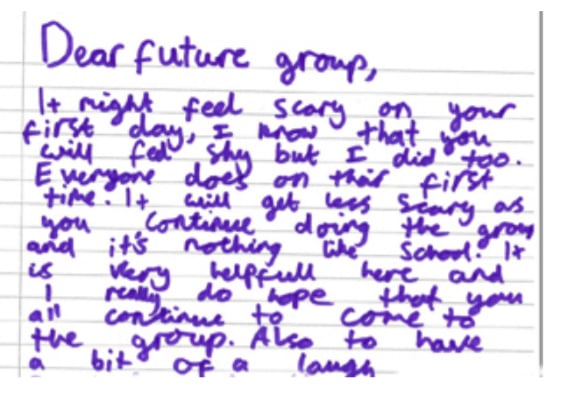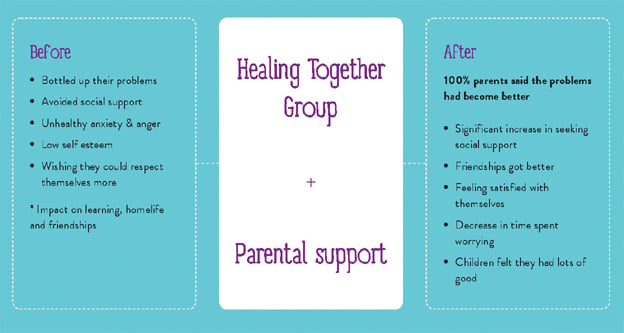The Healing Together Facilitator Programme will help to create a legion of trauma aware practitioners who will have the skills and understanding to help children who are impacted by domestic abuse and violence.
This is an ambitious world-wide training programme to upskill staff who work with children in primary or secondary schools, in other community settings, in refuges, hostels or who provide pastoral or counselling support.
Dealing with childhood trauma and domestic violence
We are the course creators and come with different perspectives from different backgrounds and that adds strength to our collaboration.
Dr Asha Patel set up her multi award winning social enterprise in 2016 with the aim of creating mentally healthy environment in schools: ‘I come from a forensic mental health background, working with high-profile sex offenders among others. I realised I was working at the wrong end of the spectrum. It was too late for them. I came to understand that I could make more impact if I supported them when they were young.’
Innovating Minds worked alongside ‘We:ARE’ in Birmingham which supports women who have been subjected to domestic violence. As the mothers started to rebuild their lives, they were concerned about the damage done to their children, so Innovating Minds developed a programme in Kings Norton in Birmingham.
Children aged 10-14 attended, one evening a week for six weeks after school After the very first session there was a waiting list for 40 children so right from the beginning it was impossible to keep up with demand.
Jane Evans is an expert on Childhood Trauma and Anxiety. She’s also the author of a number of books which help adults explore discuss difficult issues with children, including one on domestic abuse called How Are You Feeling Today Baby Bear?
She has worked in refuges, with children’s services, the courts and trained to be a foster carer. All her work draws on her experiences but is also informed by research. She is a trainer and coach and much in demand as a public speaker.
Jane was working with preschool children 26 years ago when she first learned about abusive relationships and realised that she had been in one for three years. ‘Trauma does not stop when they come out of an abusive relationship, so adults need to learn to walk in the child’s shoes. Often once the abusive partner has left ,the single parent really struggles with the child’s behaviour.’
Levels of domestic violence in lockdown
The Healing Together Facilitator Programme is especially timely now. The pandemic has not been kind to children who live in violent households. The United Nations has called domestic abuse the ‘shadow pandemic’ as it estimates incidents globally have increased by at least 20 per cent.
According to Commander Sue Williams of The Metropolitan Police there was a spike in arrests after 9 March, when people with coronavirus symptoms were asked to self-isolate. She says charges and cautions were up by 24% compared to the same period in 2019, with officers arresting an average of 100 people a day for domestic violence.
Police believe the incidents of domestic violence are under-reported as some mothers know that if their partner is arrested, they will be left with no money coming into the home.
Meanwhile, researchers at the Counting Dead Women Project told UK MPs that 14 women and two children were killed in the first three weeks of lockdown – the largest number of killings in a three-week period for 11 years and more than double the average rate.[1]
The NSPCC has confirmed a shocking increase in calls to their service: ‘Contacts to our helpline about the impact of domestic abuse on children have increased by 32% since the start of the lockdown, to an average of one an hour.’
Agencies know that these figures are just the tip of the iceberg and that many more will come to light when women and children can get out of the house and tell their stories to others. This has happened in other countries that lifted lockdown earlier.
The biggest victims of domestic abuse are often the youngest people in families
The statistics are shocking but the reality is that each of these numbers represents one or more children trapped over thirteen weeks with no chance of escape.
They have lived with daily uncertainties, threats and abuse. They will need support from safe adults to give them insights into ways to feel calmer and safer in their own bodies.
The danger is that they go back to school, struggle with their feelings and emotions and find that they cannot cope.
Adults in children’s daily lives, at school and in the community, need to understand that certain behaviours can be manifested by children who are traumatised – they must NOT be simply seen as ‘really naughty’ or ‘unmanageable.’
The children are responding to trauma and overwhelmed. Their bodies are on alert and they experience sensory overload where they react to sounds, smells, sounds, textures of food. Words, looks, silences and what seem to be minor incidents can set off feelings of danger.
They are swamped by their feelings but there is a disconnect between their mind and body so they are not always aware of what is going on.
One girl told us: ‘I love my mum, I don’t know why I do this to her’. When children are working through the course materials you will see real light bulb moment where they suddenly identify their reactions: ‘That’s what my body does too!’; ‘So that is what my brain is telling me.’
Letter from a child who attended the Healing Together project:

Healthcare workers, schools and social workers are preparing themselves to cope with a tsunami of referrals to statutory mental health services. This will have an effect on waiting lists so it is important now, more than ever, that we upskill schools, social workers, early help workers and community organisations to deliver support to children impacted by domestic abuse.
Early intervention is crucial to a child’s emotional wellbeing and education and it works better if it is delivered by people who are familiar.
There are long waiting lists for specialist mental health services such as CAMHS and it is not uncommon for children to attend one session and drop out. This is disheartening for families, the school and mental health professionals.
But the reason is that by the time children get their first CAMHS appointment they have been subject to so much scrutiny from strangers and often just want to shut down. This is why we need to train people who are not outsiders but who, in the children’s minds, are linked to schools, familiar settings and safe places.
The Healing Together Facilitator Programme builds on our work in Birmingham. Evaluations from those courses show some of the benefits.
Results from Healing Together Programme:

The Healing Together Facilitator course – helping children create a road map for life
The first thing to say is that The Healing Together Facilitator Programme is not about ‘fixing’ children. Unlike other interventions they may have experienced, it’s not a top-down cognitive process; it is not about doing things to children. It is about giving them the skills so the mind and body work together.
The Healing Together Facilitator Programme is an accredited course and is open to anyone who has experience of working with children in a therapeutic way, regardless of the setting. Some will have qualifications, perhaps in psychology or counselling, others will have relevant life experience.
Participants will get all the resources they can deliver courses either to groups or one-to-one to children aged 6 to 16.
Everything is provided and has been carefully thought through right down to the choice of colours, shapes and fonts
They will get:
- The course materials
- Packs of materials to use with children
- Details of therapeutic activities.
- Videos demonstrating how to deliver each session by Dr Asha Patel and Jane Evans.
- All the administrative paperwork including consent forms
- Special trauma-informed animations created in conjunction with Australian company ClickView
- pre-assessment semi-structured interview templates
- information about the link between mind and body
The only things a setting might need to provide are some basic art and craft material, the sort of thing most people put out for recycling.
The course is accredited, and it is important that interventions are monitored, measured and evaluated so participants will also receive copies of the Emotional Awareness Questionnaire which children will fill out before and after the course. This is easy to use with just 20 items, recorded on a scale of 1-3 with emojis to record feelings. Most importantly, it is a recognised valid assessment which is available in many languages.
This course will mean that children will be able to access therapeutic help from people they trust, in a space where they feel safe. This is a unique programme as every aspect (videos, worksheets, training) has been developed through a trauma informed lens. Experience has shown us that this is the best strategy, as children need to connect with their bodies and feelings to aid their journey to recovery.
How to apply
More details about the Healing Together programme can be found here: https://www.innovatingmindscic.com/children-impacted-domestic-abuse
- Complete the application form
- Submit a two -five video of themselves perhaps in some form of role-playing with their own child. This can be recorded on a phone and uploaded to the site
- There need to be a commitment from the setting so applicants need to obtain a reference from a manager or similar who is willing to support their application and make a commitment that they will be able to deliver courses as part of their role.
Some applicants may be invited to an online group interview.
References
[1] https://www.bbc.co.uk/news/uk-52433520
Reproduced from an article in Teaching Times: https://www.teachingtimes.com/seeing-childrens-experiences-of-domestic-violence-through-a-trauma-informed-lens-helps-their-journey-to-recovery/
